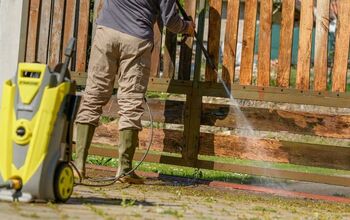Troy-Bilt Weedeater Won't Start? (Possible Causes & Fixes)

Having a weedeater, also known as a trimmer, makes lawn care all the easier. Lawnmowers can only reach so many areas around the yard and the trimmer allows for precision trimming in those tough-to-reach areas.
Sometimes, though, your Troy-Bilt weedeater may not start. There are a few things – check for a spark, check the compression and air, and the spark – that can solve the issue in short order. Troubleshooting the problem is fairly simple if you follow this guide.
Do You Need Lawn and Tree Maintenace Pros?
Get free, zero-commitment quotes from pro contractors near you.

Checking for Fuel
As dumb as it may sound, the vast majority of problems with a Troy-Bilt weedeater come from a lack of fuel. What you may not have realized is that mixed trimmer fuel can go bad in as soon as 30 days. And just like any other piece of equipment, old fuel can be detrimental to the health of the trimmer.
1. Dump old fuel. The first thing to do if your trimmer won’t start is to dump out the old fuel unless you are certain that it isn’t more than 30 days old.
2. Check the components. Before mixing together a new batch, check all of the components: the tank, the fuel lines, and the fuel filter. More often than not, there are weeds, dirt, and other types of debris that can clog up the fuel system, leading to ineffective operation.
3. Remove debris. Take out any debris that may be clogging the system and replace any components that might not be working properly, particularly if you haven’t used the trimmer in a few seasons.
Check the Air Filter
Another common culprit for your Troy-Bilt weedeater not starting is the air filter. Start by opening up the side of the air filter box and removing the air filter. Similar to clogged fuel components, dirty air filters can be found as the cause for a lot of start failures.
1. Wash the filter. Take out the filter and wash it down using soapy, warm water and give it the proper amount of time to dry; overnight should work.
2. Replace if too dirty. If the filter is too dirty to clean, replace it entirely just to ensure that the filter is in optimal condition.
3. Check the other components. Generally speaking, you will want to check the spark arrestor screen, the muffler, and the exhaust port after around 60 hours to ensure that they are working properly. Check for excessive wear and tear as well.
4. Clean the other components. Clean these components thoroughly here because a build-up can and will cause a lot of issues at startup.
Check the Spark Plug
When the spark plug in your weedeater is bad, it can’t deliver the necessary energy that the ignition needs to turn over. Start by unhooking the black rubber boot that holds the spark plug in place, unscrewing said spark plug right after.
1. Check the tip. Check the tip of the spark plug; if it looks dirty or black, simply replace it. If the current spark plug looks like it is in fine shape and can be cleaned, do so.
2. Metal tip outward. Whether you clean the old spark plug or buy a new one, put it back into the rubber boot so that the metal tip is pointing outward.
3. Pull the starter rope. From there, put the trimmer on the ground, using your foot to brace the shaft, and hold the tip of the trimmer’s plug a half-inch or so away from the metal spot that is located on the engine block. When properly positioned, give the starter rope a pull. If it works properly, you will see a blue spark.
4. Check for a spark. Don’t see a spark? That means there is a problem with the ignition system itself. From there, it will require a professional eye unless you have experience taking apart trimmers and replacing the components inside. When dealing with voltage, it is better to leave the job to the professionals.
Potential Compression Problems
Try giving the starter rope a pull. If you notice that it is either too difficult or easy to pull, you could be dealing with a compression issue. Should compression be the potential issue, hook a compression gauge up to the cylinder of the trimmer. The compression gauge is where the spark plug fits in.
From here, pump in some pressure. Just be certain to watch the readings: it should remain consistent for at least a minute or so. If the pressure starts to fall off, there is a compression leak somewhere in your engine.
Fixing Compression is for the Pros
Compression issues are just as severe as voltage issues and should be left to the professionals. Saving money on amateur work is understandable but there are certain dangers that should only be handled by a certified technician.
Carburetor Issues
On gas-powered Troy-Bilt trimmers, there is always a concern that the carburetor can get clogged. For gas trimmers, carburetors are one of the most common causes for a starting failure. Most of the time, the clogging of the carburetor is caused due to old fuel.
When the fuel evaporates, it can leave a stickier, thicker substance in its wake. That is the substance that can clog the carburetor up and prevent it from starting. Thankfully, there are specified cleaners just for an instance like this.
Clean the carburetor thoroughly and try it again. If the carburetor is still the issue, you may have to rebuild it or replace it altogether.
How Do I Know if the Carburetor is Bad?
There are a few telltale signs that the carburetor in your trimmer is going bad. The first is a major reduction in the performance of the trimmer. You may also notice that there is black smoke emanating from the trimmer as well.
Overheating or backfiring are common issues with a failing carburetor as well as all of the issues with starting it successfully. If you feel that the carburetor is a major issue, replacing it may be the best course of action.
Why Does My Weedeater Only Run on Choke?
Sometimes the trimmer can start but it may only run on choke. The reason for this is because the check valve located in the gas cap has become clogged. Start the trimmer and then unscrew the gas cap gently until about the halfway point.
From here, turn the choke off and then assess the situation. If the engine continues running, the gas cap is likely the issue. If it stops, you will have to continue to troubleshoot the issue to find another cause.
Is it Bad to Run an Engine with the Choke on?
It is rarely good for the choke to be operational while the motor is running. When you leave the choke on during operation, there are several detriments. First, you will see an excessive amount of fuel consumption that could cost over time.
Not only that, operating the trimmer with the choke on can lead to an irregular power performance in the engine and can even damage the components of the engine. Before starting, some engines may utilize a type of manual fuel primer bulb. The purpose is to enrich the ratio of the fuel in the air-fuel mixture that is crucial for that initial starting of the engine.
It Could be the Recoil Starter
Though it isn’t a regular issue with Troy-Bilt trimmers, the issue behind a faulty start could be due to the recoil starter assembly. This assembly is what engages the crankshaft and helps the engine turn over.
When the recoil starter assembly is defective, the engine will not start most of the time.
1. Remove the assembly. Take the assembly out to inspect it; when it is defective, you may notice damage immediately.
2. Pull the starter rope. When you pull on the starter rope, there will be tabs that extend out from the pully and cam that will grab onto the engine’s hub. That is what causes the engine to turn.
3. Release the rope. Releasing the rope, those tabs should then retract with the rope winding back up on the pully. If this doesn’t happen, the recoil starter assembly isn’t working right and should be replaced.
Check the Fuel Filter
Much like the air filter, it is possible for the fuel filter to become clogged over time. This is another potential issue caused by leaving old fuel in your trimmer. The fuel becomes sticky and clogs up not only the carburetor and the fuel lines but potentially the fuel filter as well.
If you’ve gone through all of the other steps, checking the viability of the different components, try draining out the old fuel from the fuel tank and replacing the fuel filter entirely. At this point, you likely will not be able to clean the old filter, and replacing it is the only way it will work.
Do You Need Lawn and Tree Maintenace Pros?
Get free, zero-commitment quotes from pro contractors near you.

Checking the Spark Arrestor
There is a small screen that keeps the engine from giving off frequent sparks known as the spark arrestor. Ove time, soot can clog up the spark arrestor, leading to the engine not starting. Though the spark arrestor is rarely the cause, it bears checking after going through the other troubleshooting methods listed above.
In order to clean and unclog the spark arrestor, simply remove it and clean it off using a wire brush. If, after cleaning it, you are still concerned about the spark arrestor being clogged or dirty, replace it entirely.
Related Guides

Ryan Womeldorf has more than a decade of experience writing. He loves to blog about construction, plumbing, and other home topics. Ryan also loves hockey and a lifelong Buffalo sports fan.
More by Ryan Womeldorf



























